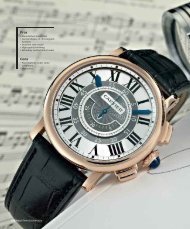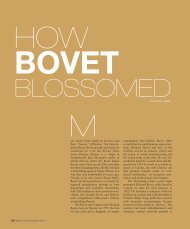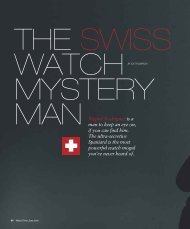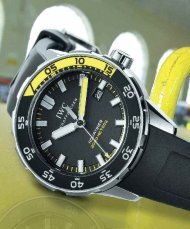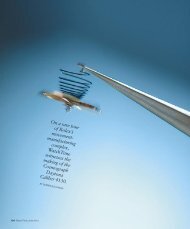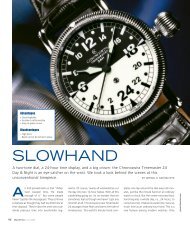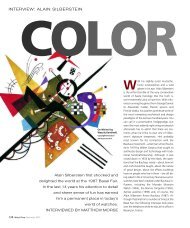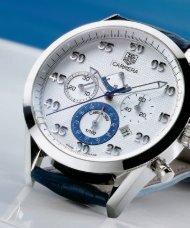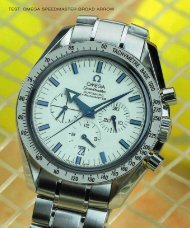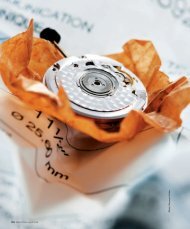WT_2007_02: PROFILE: PERRELET
WT_2007_02: PROFILE: PERRELET
WT_2007_02: PROFILE: PERRELET
Create successful ePaper yourself
Turn your PDF publications into a flip-book with our unique Google optimized e-Paper software.
Perrelet’s Jumping Hour Big<br />
Second Hand watch in rose gold
Left: This antique postcard shows<br />
an engraving of Abraham-Louis<br />
Perrelet by Charles-Samuel<br />
Girardet. Below: An 18thcentury<br />
pocket watch with<br />
automatic movement attributed<br />
to Abraham-Louis Perrelet<br />
Reviving Perrelet<br />
BY NORMA BUCHANAN<br />
Once you acquire a grand old Swiss watch name, how do you<br />
breathe life into it We asked Herbert Arni, the head of<br />
Perrelet SA.<br />
For today’s watch entrepreneurs, a good<br />
man is hard to find. Especially a good<br />
watchmaker, long dead (the longer the<br />
better), who can serve as a creditable “founding<br />
father” for a modern-day watch brand.<br />
Watch companies scour horological archives<br />
and prowl Swiss cemeteries, reading headstone<br />
inscriptions, in search of such men.<br />
So you can imagine how happy Miguel Rodriquez<br />
was when he heard that Abraham-<br />
Louis Perrelet’s name was on the market. Rodriguez,<br />
owner of the mid-priced Festina<br />
brand, is trying to gain a foothold in the luxury<br />
segment of the Swiss-watch industry. So, in<br />
2004, when Perrelet’s then-owner decided to<br />
sell the brand, Rodriguez snapped it up.<br />
Perrelet is one of the most famous watchmakers<br />
who ever lived. As nearly every watch<br />
aficionado knows, he invented the self-winding<br />
watch. The rotor he developed, or a close<br />
facsimile of it, spins tirelessly on the wrists of<br />
millions of consumers (usually visible through a<br />
glass caseback), powering the vast majority of<br />
luxury mechanical watches made today.<br />
Rodriguez bought the Perrelet brand from<br />
Flavio Audemars, who in 1993 established the<br />
Neuchâtel firm Perrelet SA to develop and market<br />
Perrelet wristwatches. (Audemars has no<br />
connection to the Audemars Piguet watch firm.)<br />
Rodriguez added Perrelet, which was virtually<br />
April <strong>2007</strong> WatchTime 123
<strong>PROFILE</strong>: <strong>PERRELET</strong><br />
Herbert Arni, CEO of Perrelet SA<br />
dead — it had some distribution in Russia, but<br />
almost none anywhere else — to a trio of<br />
brands, L. Leroy, Joseph Chevalier and Berney-<br />
Blondeau, that he had already assembled in a<br />
holding company called the H5 Groupe.<br />
“H5” is short for “Holding Hispano Helvétique<br />
de Haute Horlogerie.” “Hispano” refers to<br />
the fact that Rodriguez is Spanish; Festina is<br />
headquartered in Barcelona. “Helvétique”<br />
comes from “Helvetia,” the Latin name for<br />
Switzerland.<br />
Rodriguez chose watch-industry veteran<br />
Herbert Arni, whose prior posts included jobs<br />
with Heuer, Omega, Eterna, and Versace, to<br />
head Perrelet SA and the holding company,<br />
both based in Bienne. By spring of 2005, in<br />
time for Baselworld, the new Perrelet line was<br />
set to go.<br />
Arni’s mission has been to capitalize on the<br />
strength of the Perrelet name, which he describes<br />
as “an unbelievable asset.” To do that,<br />
he’s had to start from scratch, developing a<br />
new product line and a new way of connecting<br />
Perrelet the brand to Perrelet the man.<br />
The Right Spin<br />
It was the latter task that required the most ingenuity.<br />
After all, winding rotors are standard<br />
equipment for mechanical watches. Simply<br />
making all Perrelet watches automatics would<br />
do nothing to highlight the brand’s link to the<br />
inventor of that now ubiquitous device. Arni<br />
needed another way to make the Perrelet point.<br />
The previous owner had his own solution:<br />
a device consisting of two rotors, connected<br />
to each other. One is in the traditional position,<br />
under the movement; the other is on the<br />
dial side of the movement, visible, and sitting<br />
in a recessed circle. The bottom rotor winds<br />
the mainspring. The dial-side rotor is purely<br />
for show. Its spinning does nothing to wind<br />
the mainspring; it’s there only as “an homage<br />
to Mr. Perrelet,” Arni says.<br />
To many people’s surprise, Arni ditched the<br />
signature double-rotor (although not entirely:<br />
it lives on in two models, one round, the other<br />
a tonneau). For one thing, it was tricky to manufacture<br />
and made the watches too expensive.<br />
Arni wanted to keep Perrelet’s prices out of the<br />
stratosphere (they start at $2,850 for a big-date<br />
model with small seconds subdial). Under the<br />
Audemars ownership, the brand had been<br />
priced higher. Furthermore, Arni was leery of<br />
taking what he calls a “mono-product” approach<br />
to the brand by relying exclusively on<br />
the appeal of the double rotor.<br />
How else could he create a Perrelet-related<br />
identity for Perrelet The company’s designers<br />
came up with an answer: a way of decorating<br />
the movement that incorporates the winding<br />
rotor. The movement’s bridges are engraved<br />
with what the company calls<br />
the “Perrelet tapestry,” an elaborate<br />
pattern of interlocked<br />
“P’s.” In order to make the<br />
tapestry visible, the rotor is<br />
fitted with transparent<br />
glass. The center of the<br />
rotor bears a large “P”<br />
on a solid circle of metal<br />
that hides what Arni<br />
regards as the least attractive<br />
part of the<br />
movement. The rotor is<br />
manufactured by DTH,<br />
or Dubois Technique<br />
Horlogère, a maker of<br />
components and modules,<br />
Five Minute<br />
Repeater in<br />
rose gold<br />
owned by<br />
Rodriguez and<br />
located in the Vallée<br />
de Joux. “The goal of<br />
this exercise is that in one,<br />
two or three years, the consumer<br />
turns the watch over and<br />
says ‘This must be a Perrelet, because<br />
only they do this,’” Arni says.<br />
The Perrelet tapestry-cum-transparent rotor<br />
was one way to distinguish the brand, but Arni<br />
wanted others. He knew that if the brand were<br />
to claim to be the spiritual heir of Abraham-<br />
Louis Perrelet, simply sticking a standard automatic<br />
movement in a case would not suffice. “If<br />
you are the inventor of the automatic, you cannot<br />
just buy a [Valjoux] 2892, put it in a nice case<br />
and say, ‘This is an automatic watch, and, by the<br />
way, I am the inventor of this.’<br />
“On the other hand, we did not have the<br />
A current Perrelet movement with the<br />
“Perrelet tapestry” visible through the<br />
transparent winding rotor<br />
124 WatchTime April <strong>2007</strong>
<strong>PROFILE</strong>: <strong>PERRELET</strong><br />
NEXT UP: L. LEROY<br />
Now that Perrelet is off the launching pad, its<br />
owner, the H5 Groupe, is getting another<br />
brand ready.<br />
It’s called L. Leroy (pronounced “le WAH”).<br />
Its origins stretch back to a French watchmaking<br />
family that rose to prominence in the<br />
18th century. (It is not to be confused with<br />
the le Roy family whose most famous member,<br />
Pierre, is credited with inventing the<br />
detent escapement for use in marine<br />
chronometers.) The L. Leroy of the brand’s<br />
name is Louis Leroy, who joined the family<br />
firm in 1879.<br />
H5 bought the L. Leroy brand in 2004, just<br />
before buying Perrelet. L. Leroy was still making<br />
watches, but they were sold in a tiny<br />
number of stores. Annual production was<br />
only about 400 pieces per year. As it did with<br />
Perrelet, H5 is revamping both the products<br />
and the distribution, and plans to re-launch<br />
the brand at the end of this year, says Herbert<br />
Arni, the head of H5. L. Leroy will be expensive,<br />
in the range of, say, Breguet, and very<br />
narrowly distributed. The collection will be introduced<br />
first in Italy, Switzerland, France and<br />
Spain. Other markets will follow later.<br />
Next year, L Leroy will get its own exclusive<br />
movement, developed and manufactured by<br />
H5’s sister company, DTH (Dubois Technique<br />
Horlogère), which makes modules and movement<br />
components, for H5 and other companies,<br />
in the Vallée de Joux. “It isn’t possible to<br />
put Leroy on the market without it having its<br />
own movement,” Arni says<br />
Both H5 and DTH are owned by Spanish<br />
watch entrepreneur Miguel Rodriguez. His<br />
Barcelona-based Festina Group has a stable of<br />
mid-priced, mostly quartz brands: Festina, Lotus,<br />
Calypso, Jaguar and Candino. Over the<br />
past several years, Rodriguez has been on a<br />
shopping spree, buying up well-known,<br />
and not-so-well known, brand names, intent<br />
on becoming a player in the world of<br />
haute horlogerie. He now has four brands<br />
under the H5 umbrella.<br />
The two others are Berney-<br />
Blondeau and Joseph Chevalier, the<br />
former an old brand from the Vallée<br />
de Joux, the latter named for a<br />
19th-century Geneva watchmaker.<br />
Both will spend a while “in<br />
the fridge,” Arni says. Look for<br />
them in a few years, maybe<br />
around 2010.<br />
money, the time or the capacity to make our own<br />
movement,” Arni says. “This is an exercise of five<br />
years with three to five million [Swiss francs] up<br />
front. And then you don’t know if it works.”<br />
Arni’s solution is to use ETA movements,<br />
assembled not by ETA but by a third party,<br />
combined with modules made exclusively for<br />
Perrelet by companies including Dubois<br />
Dépraz and DTH.<br />
Simple Complications<br />
His strategy in developing new products is to<br />
incorporate just one or two complications in a<br />
watch, making those complications as userfriendly<br />
as possible. “We are not in the gadget<br />
business, combining an alarm with a tripletime-zone<br />
watch and adding a chronograph,<br />
which nobody can read and no sales staff can<br />
sell,” Arni says. The designers focused on readability,<br />
so that nearly all the date displays are<br />
so-called “big dates,” and the power-reserve<br />
indicators are far larger than on most watches.<br />
The line contains 14 distinct models (there<br />
are some 300 distinct styles, if you include variations<br />
in case materials, straps, etc.). Several of<br />
the steel models are priced at under $5,000:<br />
the steel chronograph with big date is $4,250;<br />
the steel double rotor is $3,600. At the top of<br />
the price range are such pieces as the limitededition<br />
platinum automatic tourbillon, for<br />
$90,000 (rose-gold and steel tourbillons are<br />
$60,000 and $52,500, respectively).<br />
Last year, the company introduced a fiveminute<br />
repeater ($29,900 in rose gold) and a<br />
jumping hour ($5,575 in steel,<br />
$15,675 in palladium and $17,000 in<br />
gold). The company also added a<br />
large-moonphase watch to its<br />
women’s collection. As you might<br />
guess, the women’s Perrelet<br />
models are all automatics.<br />
They’re priced from about<br />
$5,000 to $10,000.<br />
The five-minute repeater<br />
was something of a<br />
pet project for Arni, who<br />
The Double Rotor features a<br />
second rotor on the dial,<br />
strictly for show.<br />
COSC-certified automatic flying tourbillon in<br />
stainless steel<br />
believes repeaters are the next wave in complications.<br />
Perrelet came late to the tourbillon party<br />
with its COSC-certified automatic chronometer<br />
tourbillon, but intends to get in on the<br />
ground floor with five-minute repeaters, which<br />
offer a more affordable alternative to minute repeaters.<br />
Perrelet’s version, like the new jumping<br />
hour, incorporates a Dubois Dépraz module.<br />
Perrelet watches are styled in what Arni calls<br />
a “classic-contemporary” mode. The sides of<br />
the case bear a modern-looking pattern of vertical<br />
striations, and most of the dials are decorated<br />
with a striped pattern emanating from<br />
the center of the dial.<br />
The Toast of Le Locle<br />
In developing the new products, Perrelet SA<br />
got little help either from extant watches made<br />
by Perrelet himself or from historical documents.<br />
Other brands bearing the names of famous<br />
watchmakers, brands like Patek Philippe,<br />
Vacheron Constantin, Breguet and Audemars<br />
Piguet, have a wealth of antique and vintage<br />
watches, as well as archival material, to draw<br />
on. Perrelet has next to nothing.<br />
One reason is that, following the custom of<br />
Abraham-Louis Perrelet’s time (he lived from<br />
1729 to 1826) and his location (canton<br />
Neuchâtel), he did not sign his watches. The<br />
126 WatchTime April <strong>2007</strong>
<strong>PROFILE</strong>: <strong>PERRELET</strong><br />
SELF-WINDING THROUGH<br />
THE CENTURIES<br />
An automatic movement from an 18thcentury<br />
watch attributed to Abraham-<br />
Louis Perrelet<br />
A view of the movement inside a Harwood<br />
watch from the 1920s<br />
A view of the rotor in a Rolex Oyster from<br />
the 1930s<br />
Abraham-Louis Perrelet would be surprised, and no<br />
doubt delighted, if he walked into a watch store<br />
today. There, in showcase after showcase, he’d see<br />
watches fitted with the automatic winding system<br />
— many of them showing off their elaborately decorated<br />
rotors through transparent casebacks —<br />
that he invented some 237 years ago. Perrelet,<br />
described by one author as a “retiring inventor of<br />
genius,” was a modest homebody who spent his<br />
entire life in the watchmaking town of Le Locle. It’s<br />
safe to say he had no inkling of what would<br />
become of his winding rotor.<br />
In fact, Perrelet didn’t invent the concept of<br />
winding with an oscillating weight. It probably<br />
dates back to the 17th century. But early experiments<br />
in self-winding never amounted to much. A<br />
19th-century book, Histoire de l’horlogerie, by<br />
Pierre Dubois, describes them as follows: “…The<br />
mechanism of these timepieces was so defective<br />
and worked so badly, that these early perpetual<br />
watches soon came to be considered mere<br />
baubles, mere fashionable novelties.”<br />
Perrelet is universally credited with being the first<br />
to make an automatic-winding system that actually<br />
worked. Two of the foremost authorities on the<br />
subject, Alfred Chapuis and Eugène Jaquet, authors<br />
of The History of the Self-Winding Watch, write,<br />
“…the manufacture of the first really complete and<br />
technically sound self-winder can be attributed to<br />
Abraham-Louis Perrelet.”<br />
He used two types of winding weights in his automatic<br />
watches, the authors write. One was oval or<br />
round, and swung back and forth on a pivot in the<br />
manner of a pendulum (except that its swings were<br />
halted in either direction by banking pins). The<br />
other, familiar to watch owners today, used a<br />
semicircular, fan-shaped rotor that spun around<br />
pieces attributed to him have been identified<br />
through detective work. Furthermore, Abraham-Louis<br />
Perrelet did not found a company,<br />
so there was none to keep his name in the<br />
public eye through successive generations.<br />
His grandson, Louis-Frédéric Perrelet,<br />
achieved some celebrity as the official watchmaker<br />
to the French kings Louis XVIII, Charles<br />
X and Louis-Philippe, and one emperor,<br />
Napoleon III. He is also known for having<br />
patented a split-seconds chronograph in<br />
1827. But after he died, in 1854, the Perrelet<br />
name entered watchmaking oblivion.<br />
In Abraham-Louis’s day, though, it echoed<br />
through the Jura Mountains. He was born in<br />
Le Locle on June 9, 1729, the son of a wellknown<br />
maker of watchmaking tools. (His first<br />
name was actually spelled “Abram-Louis” in<br />
the Neuchâtel manner, as was, originally, the<br />
first name of Abraham-Louis Breguet, and it is<br />
this spelling that is most often seen in old horological<br />
history books. The names of both<br />
watchmakers later morphed into the more<br />
common “Abraham.”)<br />
Perrelet made his first automatic watch<br />
sometime around 1770. The renowned horological<br />
historians Alfred Chapuis and Eugène<br />
Jaquet write in their book, The History of the<br />
Self-Winding Watch, that Perrelet used two<br />
different types of oscillating weights in his au-<br />
128 WatchTime April <strong>2007</strong>
360 degrees on a center pivot, winding the watch<br />
regardless of which way it was turning.<br />
During Perrelet’s lifetime and some decades<br />
thereafter, it was the former system that prevailed.<br />
Breguet refined the back-and-forth mechanism and<br />
fit it into his famous perpetuelle watches, and other<br />
watchmakers, including Louis Recordon and the<br />
Jaquet-Droz firm, also adopted it. Historians think<br />
the reason the spinning rotor was abandoned was<br />
that it did not generate enough power. In those<br />
days, all watches were, of course, pocket or pendant<br />
watches, and were not subjected to as much<br />
motion as wristwatches are.<br />
In their first decades, automatic watches made<br />
quite a splash and were produced in large numbers.<br />
But even the back-and-forth type of self-winders<br />
presented problems. If not expertly manufactured,<br />
they didn’t work. They were very expensive to<br />
produce, and few people knew how to repair them.<br />
And they were big: the winding weight added appreciable<br />
thickness in an era when thin watches<br />
were definitely in.<br />
Around 1840, the self-winding mechanism<br />
received a near-fatal blow: the introduction of keyless<br />
winding, which eliminated automatic winding’s<br />
biggest reason for being. Self-winding had been<br />
invented chiefly because key winding was such a<br />
nuisance. Not only did the watch owner need to<br />
keep his winding key with him, he risked chipping<br />
or scratching his watch’s dial whenever he inserted<br />
the key into the key aperture. Furthermore, this<br />
hole provided an entry point for dirt and dust. So<br />
when key winding disappeared, so too, for all<br />
practical purposes, did automatic winding.<br />
Until the wristwatch came along. When, during<br />
World War I, soldiers began wearing wristwatches<br />
in large numbers, automatic winding once again<br />
tomatic watches. One was a banked weight,<br />
later adopted by Breguet, whom he knew and<br />
to whom he sold some watches; the other was<br />
a spinning rotor like that used today. Perrelet’s<br />
watches were extremely popular during his<br />
lifetime, and helped make him something of a<br />
horological celebrity.<br />
So did his other accomplishments. Chapuis<br />
and Jaquet describe him as a craftsman<br />
par excellence, celebrated throughout canton<br />
Neuchâtel. He was the first Le Locle watchmaker<br />
to work on cylinder escapements and<br />
on such complications as calendars and equation<br />
of time devices, they write. They quote a<br />
book entitled Biographie Neuchâteloise dehad<br />
a raison d’etre. Wristwatches were exposed<br />
to much more dirt and dust than pocket<br />
watches because they were unsheltered from<br />
the elements. This dirt entered the watch<br />
through the winding-stem hole.<br />
The problem was especially acute in trench<br />
warfare. In the 1920s, John Harwood, a British<br />
watchmaker who had fought in the war,<br />
resurrected Perrelet’s old concept of a centrally<br />
pivoted winding weight and applied it to a<br />
wristwatch. Because wristwatches are subjected<br />
to more motion than pocket watches, the rotor<br />
concept would work in them, he realized.<br />
Harwood’s watch had no crown; the owner set<br />
the time by turning the bezel. There was<br />
therefore no way for dirt to get into the case.<br />
Harwood’s watches may have been dirt-free,<br />
but several technical flaws nonetheless doomed<br />
them. The biggest was the shocks that shook<br />
the movement every time the rotor hit one of<br />
the banking springs. The Harwood watch was<br />
abandoned in just a few years.<br />
In 1931, Rolex succeeded where Harwood<br />
had failed. It adapted Perrelet’s centrally pivoted<br />
rotor in a different way than Harwood had:<br />
instead of the rotor moving through an arc, and<br />
being stopped on either side by banking<br />
springs, the rotor swung around freely in either<br />
direction, just like Perrelet’s rotor had done. This<br />
eliminated the shocks that had plagued<br />
Harwood’s watches. (Rolex had solved the dirt<br />
problem five years earlier by introducing the first<br />
truly impermeable watch case, which it incorporated<br />
in its Oyster models.)<br />
Today’s automatic watches use essentially the<br />
same system. Perrelet, modest though he was,<br />
would surely be proud.<br />
scribing him as “the master of all watchmakers<br />
of Le Locle.” Whenever other Le Locle<br />
watchmakers had a problem they couldn’t<br />
solve, they would say to each other, “Let’s go<br />
to old Perrelet,” according to the Biographie.<br />
And old he became, making entire watches<br />
from scratch well into his 90s. He completed a<br />
lever-escapement watch at age 95. Earlier in<br />
his career, the town of Neuchâtel had tried to<br />
lure him away from Le Locle, but to no avail.<br />
He died there at 97.<br />
Although he left few watches to remember<br />
him by, we have plenty of evidence of his<br />
ingenuity. You need look no further than<br />
your wrist.<br />
■<br />
April <strong>2007</strong> WatchTime 129



